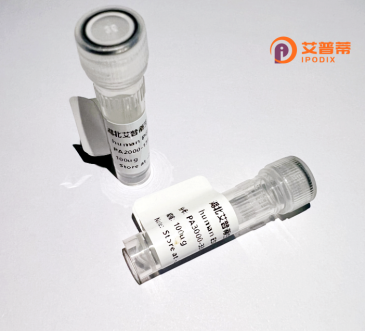
| 纯度 | >90%SDS-PAGE. |
| 种属 | Human |
| 靶点 | HCNGP |
| Uniprot No | Q9UHR5 |
| 内毒素 | < 0.01EU/μg |
| 表达宿主 | E.coli |
| 表达区间 | 91-308aa |
| 氨基酸序列 | TEAEKRDPQELVASFSERVRNMSPDEIKIPPEPPGRCSNHLQDKIQKLYERKIKEGMDMNYIIQRKKEFRNPSIYEKLIQFCAIDELGTNYPKDMFDPHGWSEDSYYEALAKAQKIEMDKLEKAKKERTKIEFVTGTKKGTTTNATSTTTTTASTAVADAQKRKSKWDSAIPVTTIAQPTILTTTATLPAVVTVTTSASGSKTTVISAVGTIVKKAKQ |
| 分子量 | 28.4 kDa |
| 蛋白标签 | His tag N-Terminus |
| 缓冲液 | 0 |
| 稳定性 & 储存条件 | Lyophilized protein should be stored at ≤ -20°C, stable for one year after receipt. Reconstituted protein solution can be stored at 2-8°C for 2-7 days. Aliquots of reconstituted samples are stable at ≤ -20°C for 3 months. |
| 复溶 | Always centrifuge tubes before opening.Do not mix by vortex or pipetting. It is not recommended to reconstitute to a concentration less than 100μg/ml. Dissolve the lyophilized protein in distilled water. Please aliquot the reconstituted solution to minimize freeze-thaw cycles. |
以下是关于重组人HCNGP(假设为超极化激活环核苷酸门控通道相关蛋白)或类似蛋白的文献示例。由于“HCNGP”可能为拼写变异,以下参考了HCN通道家族及相关重组蛋白的研究:
---
1. **文献名称**: "Expression and Functional Characterization of Recombinant Hyperpolarization-Activated Cyclic Nucleotide-Gated Channels in Mammalian Cells"
**作者**: Ludwig A., Zong X., Hofmann F., et al.
**摘要**: 该研究报道了重组人HCN1、HCN2和HCN4通道蛋白在HEK293细胞中的表达与功能分析,通过电生理实验验证了其超极化激活特性和环核苷酸调控机制,为心律失常相关研究提供基础。
2. **文献名称**: "Purification and Structural Analysis of HCN Channel Voltage-Sensing Domains"
**作者**: Lee C.H., MacKinnon R.
**摘要**: 作者通过重组技术表达了人HCN通道的电压敏感结构域,利用X射线晶体学解析其三维结构,揭示了门控机制中的关键氨基酸残基,并探讨其在神经和心脏疾病中的潜在应用。
3. **文献名称**: "Role of HCN Channels in Neuronal Excitability and Neuropathic Pain"
**作者**: Emery E.C., Young G.T., McNaughton P.A.
**摘要**: 该研究利用重组HCN2蛋白模型,验证其在背根神经节神经元中的表达对疼痛信号传导的影响,表明抑制HCN2活性可缓解神经性疼痛,为药物靶点开发提供依据。
4. **文献名称**: "Recombinant Production of Human HCN1 in Escherichia coli and Functional Reconstitution into Lipid Bilayers"
**作者**: Pian P., Bucchi A., Robinson R.B., et al.
**摘要**: 开发了一种高效的大肠杆菌表达系统生产重组人HCN1蛋白,并通过脂质体重组验证其离子通道功能,为大规模制备及药物筛选提供技术方案。
---
**注意**:若“HCNGP”为特定变体或新型蛋白,建议核实名称准确性或扩展搜索关键词(如“HCN glycoprotein”或结合研究领域调整)。以上文献以HCN通道家族为例,供参考其相关研究方向与方法。
Recombinant human HCNGP (Hyperpolarization-activated Cyclic Nucleotide-Gated Channel Glycoprotein) proteins are engineered variants of ion channels critical for regulating cellular electrical activity. Belonging to the HCN family, these channels underlie the "funny current" (If) that drives spontaneous rhythmic firing in pacemaker cells of the heart (e.g., sinoatrial node) and specific neurons. HCN channels are voltage-gated, activated by membrane hyperpolarization, and modulated by cyclic nucleotides like cAMP, linking cellular signaling to electrical excitability. Four isoforms (HCN1–4) exist in humans, each with distinct activation kinetics and tissue expression profiles. Dysregulation of HCN channels is implicated in arrhythmias, neurological disorders, and chronic pain.
Recombinant HCNGP proteins are typically produced using heterologous expression systems (e.g., HEK293 cells, *E. coli*) to study channel structure-function relationships, drug interactions, or disease mechanisms. By enabling precise control over isoform composition and post-translational modifications, these proteins facilitate research into channelopathies and therapeutic targeting. For example, HCN4 mutations are linked to inherited sinus node dysfunction, while HCN2/HCN1 modulation is explored for epilepsy or pain management. Advances in cryo-EM and electrophysiology have recently illuminated HCN gating mechanisms, spurring interest in designing isoform-specific inhibitors or activators. Recombinant HCNGP thus serves as a vital tool for both basic research and translational applications in cardiology and neuroscience.
×